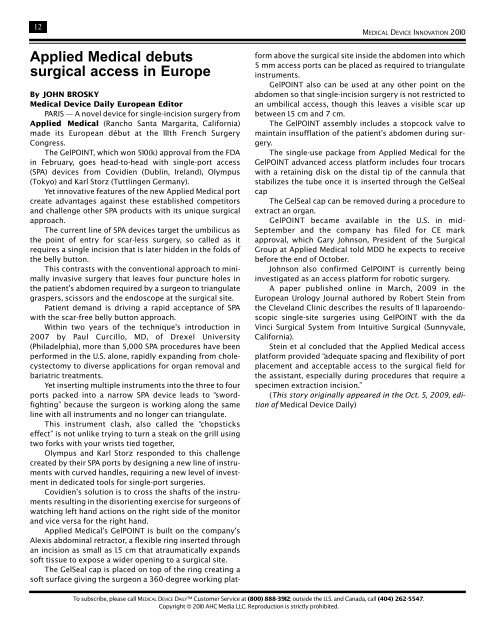MEDICAL DEVICE INNOVATION - Medical Device Daily
MEDICAL DEVICE INNOVATION - Medical Device Daily
MEDICAL DEVICE INNOVATION - Medical Device Daily
You also want an ePaper? Increase the reach of your titles
YUMPU automatically turns print PDFs into web optimized ePapers that Google loves.
12<br />
Applied <strong>Medical</strong> debuts<br />
surgical access in Europe<br />
<strong>MEDICAL</strong> <strong>DEVICE</strong> <strong>INNOVATION</strong> 2010<br />
By JOHN BROSKY<br />
<strong>Medical</strong> <strong>Device</strong> <strong>Daily</strong> European Editor<br />
PARIS — A novel device for single-incision surgery from<br />
Applied <strong>Medical</strong> (Rancho Santa Margarita, California)<br />
made its European début at the 111th French Surgery<br />
Congress.<br />
The GelPOINT, which won 510(k) approval from the FDA<br />
in February, goes head-to-head with single-port access<br />
(SPA) devices from Covidien (Dublin, Ireland), Olympus<br />
(Tokyo) and Karl Storz (Tuttlingen Germany).<br />
Yet innovative features of the new Applied <strong>Medical</strong> port<br />
create advantages against these established competitors<br />
and challenge other SPA products with its unique surgical<br />
approach.<br />
The current line of SPA devices target the umbilicus as<br />
the point of entry for scar-less surgery, so called as it<br />
requires a single incision that is later hidden in the folds of<br />
the belly button.<br />
This contrasts with the conventional approach to minimally<br />
invasive surgery that leaves four puncture holes in<br />
the patient’s abdomen required by a surgeon to triangulate<br />
graspers, scissors and the endoscope at the surgical site.<br />
Patient demand is driving a rapid acceptance of SPA<br />
with the scar-free belly button approach.<br />
Within two years of the technique’s introduction in<br />
2007 by Paul Curcillo, MD, of Drexel University<br />
(Philadelphia), more than 5,000 SPA procedures have been<br />
performed in the U.S. alone, rapidly expanding from cholecystectomy<br />
to diverse applications for organ removal and<br />
bariatric treatments.<br />
Yet inserting multiple instruments into the three to four<br />
ports packed into a narrow SPA device leads to “swordfighting”<br />
because the surgeon is working along the same<br />
line with all instruments and no longer can triangulate.<br />
This instrument clash, also called the “chopsticks<br />
effect” is not unlike trying to turn a steak on the grill using<br />
two forks with your wrists tied together,<br />
Olympus and Karl Storz responded to this challenge<br />
created by their SPA ports by designing a new line of instruments<br />
with curved handles, requiring a new level of investment<br />
in dedicated tools for single-port surgeries.<br />
Covidien’s solution is to cross the shafts of the instruments<br />
resulting in the disorienting exercise for surgeons of<br />
watching left hand actions on the right side of the monitor<br />
and vice versa for the right hand.<br />
Applied <strong>Medical</strong>’s GelPOINT is built on the company’s<br />
Alexis abdominal retractor, a flexible ring inserted through<br />
an incision as small as 1.5 cm that atraumatically expands<br />
soft tissue to expose a wider opening to a surgical site.<br />
The GelSeal cap is placed on top of the ring creating a<br />
soft surface giving the surgeon a 360-degree working platform<br />
above the surgical site inside the abdomen into which<br />
5 mm access ports can be placed as required to triangulate<br />
instruments.<br />
GelPOINT also can be used at any other point on the<br />
abdomen so that single-incision surgery is not restricted to<br />
an umbilical access, though this leaves a visible scar up<br />
between 1.5 cm and 7 cm.<br />
The GelPOINT assembly includes a stopcock valve to<br />
maintain insufflation of the patient’s abdomen during surgery.<br />
The single-use package from Applied <strong>Medical</strong> for the<br />
GelPOINT advanced access platform includes four trocars<br />
with a retaining disk on the distal tip of the cannula that<br />
stabilizes the tube once it is inserted through the GelSeal<br />
cap<br />
The GelSeal cap can be removed during a procedure to<br />
extract an organ.<br />
GelPOINT became available in the U.S. in mid-<br />
September and the company has filed for CE mark<br />
approval, which Gary Johnson, President of the Surgical<br />
Group at Applied <strong>Medical</strong> told MDD he expects to receive<br />
before the end of October.<br />
Johnson also confirmed GelPOINT is currently being<br />
investigated as an access platform for robotic surgery.<br />
A paper published online in March, 2009 in the<br />
European Urology Journal authored by Robert Stein from<br />
the Cleveland Clinic describes the results of 11 laparoendoscopic<br />
single-site surgeries using GelPOINT with the da<br />
Vinci Surgical System from Intuitive Surgical (Sunnyvale,<br />
California).<br />
Stein et al concluded that the Applied <strong>Medical</strong> access<br />
platform provided “adequate spacing and flexibility of port<br />
placement and acceptable access to the surgical field for<br />
the assistant, especially during procedures that require a<br />
specimen extraction incision.”<br />
(This story originally appeared in the Oct. 5, 2009, edition<br />
of <strong>Medical</strong> <strong>Device</strong> <strong>Daily</strong>)<br />
To subscribe, please call <strong>MEDICAL</strong> <strong>DEVICE</strong> DAILY Customer Service at (800) 888-3912; outside the U.S. and Canada, call (404) 262-5547.<br />
Copyright © 2010 AHC Media LLC. Reproduction is strictly prohibited.
















